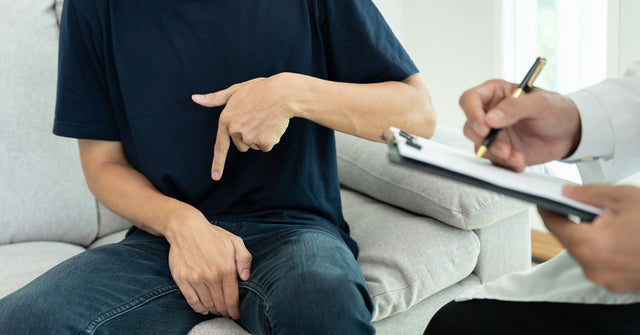What is Erectile Dysfunction (ED)?
Erectile dysfunction (ED) refers to the consistent inability to achieve or maintain an erection sufficient for satisfactory sexual performance. It is a common condition affecting men of all ages, but it becomes more prevalent as the years advance. ED may have a significant emotional and psychological impact on some men, negatively affecting self-esteem, relationships, and overall quality of life.
Causes of Erectile Dysfunction (ED)
Erectile dysfunction has several possible causes, which fall into the general categories of physical, psychological, and lifestyle factors.
Physical Factors
-
Vascular Issues: Reduced blood flow to the penis due to conditions like atherosclerosis (plaque buildup in the arteries), high blood pressure, or peripheral vascular disease could cause erectile issues.
-
Neurological Disorders: Conditions that impact the nerve signals involved in arousal, such as multiple sclerosis or Parkinson's disease, may lead to erectile dysfunction.
-
Hormonal Imbalances: Low testosterone levels or thyroid disorders could impact erectile function.
-
Penile Anomalies or Injuries: Conditions like Peyronie's disease (scar tissue inside the penis) or trauma to the penis may lead to erectile function issues.
Psychological Factors
-
Performance Anxiety: Stress or anxiety related to sexual performance may impact erectile function.
-
Depression: Mental health issues that affect overall libido and sexual function may also impact erections.
-
Relationship Problems: Issues within a relationship or communication difficulties can also cause problems like erectile dysfunction in the bedroom.
Lifestyle Factors
-
Smoking: Regular tobacco use can damage blood vessels and restrict the flow of blood to the penis. Exposure to the nicotine and chemicals in vapes may also be a risk factor for erectile dysfunction.
-
Alcohol Consumption: Excessive drinking can impair nerve function and decrease testosterone levels over time, which could lead to erectile dysfunction.
-
Drug Use: Using drugs or misusing medications may interfere with sexual arousal and performance.
The Importance of Exercise in Managing Erectile Dysfunction (ED)
Exercise plays a crucial role in managing erectile dysfunction (ED) by addressing the physical and psychological factors that may contribute to the condition. These are the key benefits of exercise for ED:
- Supports cardiovascular health
- Helps enhance endothelial function
- Eases stress and anxiety
- Supports hormonal balance
- Strengthens pelvic floor muscles
- Helps with weight management
Cardiovascular Exercise for Erectile Dysfunction
Cardiovascular exercises can play a crucial role in improving overall heart health, which directly impacts erectile function. By enhancing circulation throughout the body, including to the penis, these exercises can help manage and potentially alleviate erectile dysfunction. Here's how cardiovascular exercise can benefit men experiencing ED:
Improves Blood Circulation
Cardiovascular exercises such as brisk walking, jogging, cycling, and swimming increase heart rate and enhance circulation throughout the body. This elevated blood flow is essential for achieving and maintaining erections, as it facilitates the delivery of oxygen and nutrients to the erectile tissue of the penis.
Enhances Endothelial Function
The inner lining of blood vessels called the endothelium plays a crucial role in regulating vascular tone and blood flow. Regular cardiovascular exercise can improve endothelial function, enhancing vasodilation and improving the responsiveness of blood vessels in the penis during arousal.
Reduces Cardiovascular Risk Factors
Several risk factors for cardiovascular disease including hypertension, atherosclerosis, and obesity are also associated with erectile dysfunction. By addressing these factors through exercise, men can reduce their likelihood of developing ED or experiencing its progression.
Supports Weight Management
Obesity is a significant risk factor for both cardiovascular disease and erectile dysfunction. Cardiovascular exercises help burn calories, promote weight loss, and maintain a healthy body weight, which could improve overall metabolic and heart health.
Best Cardiovascular Exercises For ED
These are our recommendations for some of the most effective cardiovascular exercises men with erectile dysfunction should incorporate into their routines.
Aerobic Exercises
- Brisk Walking: A low-impact exercise that can easily be incorporated into daily routines
- Running/Jogging: Higher-intensity aerobic exercise that boosts cardiovascular fitness
- Cycling: Provides cardiovascular benefits while also being gentle on the joints
- Swimming: Whole-body exercise that improves cardiovascular health without stressing the joints
Interval Training
Alternating between high-intensity bursts of exercise followed by periods of lower intensity or rest can be particularly effective for improving cardiovascular fitness and promoting weight loss.
Group Fitness Classes
Classes like aerobics, Zumba, or spinning provide structured workouts that can make exercising more enjoyable and social.
Considerations for Starting Cardiovascular Exercises
-
Consultation with a Healthcare Provider: Before starting any exercise program, especially if you have existing cardiovascular conditions or other health concerns, it’s important to consult with a healthcare provider to ensure safety and suitability.
-
Gradual Progression: Start with low-intensity exercises and gradually increase duration and intensity as your fitness level improves.
-
Consistency: To reap the benefits of cardiovascular exercises for erectile dysfunction, consistency is key. Aim for at least 150 minutes of moderate-intensity aerobic activity per week, spread throughout the week.
Other Helpful Exercises For ED
Pelvic Floor (Kegel) Exercises
Pelvic floor, or Kegel, exercises are a valuable, non-invasive treatment option for managing erectile dysfunction (ED) which specifically target the muscles involved in urinary control and sexual function.
By strengthening the pelvic floor muscles, Kegel exercises may improve erectile strength, control, and overall sexual satisfaction. Here’s how they work and their benefits:
How to Perform Kegel Exercises
1. Locate the Muscles
Basic Kegel Exercise Technique:-
Sit or lie down comfortably with your muscles relaxed.
-
Contract the pelvic floor muscles by squeezing them for 3-5 seconds.
-
Relax the muscles for the same amount of time.
-
Repeat this contraction and relaxation process for 10-15 repetitions, 3 times daily.
2. Advanced Technique
-
Once you are comfortable with basic Kegel exercises, try holding the contraction longer (up to 10 seconds) or increasing the number of repetitions.
-
Incorporate quick contractions by rapidly tightening and releasing the muscles to improve their endurance.
3. Consistency is Key
As with any exercise, consistency is crucial if you want real results. Aim to perform Kegel exercises daily, gradually increasing the intensity as your muscles get stronger.
Resistance Training
Resistance training, also known as strength training or weightlifting, offers numerous benefits for overall health and can also be effective in managing erectile dysfunction (ED). By targeting muscle groups throughout the body, resistance training may not only improve strength and endurance but also promote hormonal balance and enhance cardiovascular health—factors that can positively influence erectile function.
Start with a Warm-Up
Begin with a 5-10 minute warm-up session to prepare your muscles and joints. This may include light cardiovascular exercises like jogging or jumping jacks.
Choose Your Exercises
Focus on compound exercises that engage multiple muscle groups simultaneously, such as:
- Squats: Targets the legs, glutes, and core
- Deadlifts: Engages the lower back, glutes, and hamstrings
- Bench Press: Targets the chest, shoulders, and triceps
- Rows: Works the upper back and biceps
Use Proper Form
Follow the correct form for each exercise to avoid injury and maximize effectiveness. Start with lighter weights or resistance bands if you are new to resistance training.
Progress Gradually
Gradually increase the intensity (weight or resistance) and repetitions as your strength improves. Aim for 8-12 repetitions per set for each exercise.
Include Rest Days
Allow your muscles time to recover by alternating resistance training days with rest or lighter activity days.
Consult a Trainer
If you are new to resistance training or have specific health concerns, consider working with a certified personal trainer who can create a customized program tailored to your needs.
Yoga and Stretching
Yoga and stretching exercises offer a gentle yet effective approach to managing erectile dysfunction (ED) by promoting relaxation, improving flexibility, and enhancing overall circulation. These practices not only reduce stress—an important contributor to ED—but also support physical health and mental well-being.
Best Yoga Poses for Erectile Dysfunction
1. Downward-Facing Dog (Adho Mukha Svanasana)
- Helps stretch the entire body, especially the spine, hamstrings, and calves
- Promotes blood circulation throughout the body
2. Cobra Pose (Bhujangasana)
- Stretches the spine and opens the chest, improving posture and breathing
- Stimulates the abdominal organs and enhances blood flow to the pelvic area
3. Bridge Pose (Setu Bandhasana)
- Strengthens the back, buttocks, and legs
- Improves the flexibility of the spine and stretches the chest, neck, and spine
Stretching Exercises
1. Hamstring Stretch
- Sit on the floor with one leg extended and the other bent, with the sole of your foot against your inner thigh.
- Lean forward gently to stretch the hamstring of the extended leg.
- Hold for 20-30 seconds and switch sides.
2. Quad Stretch
- Stand upright and hold onto a stable surface for balance.
- Bend one knee and grab your ankle or foot with your hand.
- Pull your foot towards your buttocks to stretch the quadriceps muscle.
- Hold for 20-30 seconds and switch sides.
Breathing and Relaxation Techniques
Practice deep breathing exercises (pranayama) such as diaphragmatic or alternate nostril breathing to reduce stress and promote relaxation.
Lifestyle Changes to Support Exercise
Making lifestyle changes can significantly enhance the benefits of exercise in managing erectile dysfunction (ED). Here are some of the best modifications you can make to support erectile health:
-
Quit Smoking: Smoking restricts blood flow and damages blood vessels, potentially contributing to ED. Over time, quitting smoking can improve heart health and increase exercise performance.
-
Limit Alcohol Consumption: Excessive, regular alcohol consumption may impair nerve function and reduce testosterone levels, affecting erectile function. Moderation or abstinence supports optimal sexual health.
-
Follow a Healthy Diet: A balanced diet rich in fruits, vegetables, lean proteins, and whole grains can support cardiovascular health and improve erectile function. In addition, it provides essential nutrients that contribute to overall well-being. Incorporate the best vitamins, minerals, and amino acids for erectile strength, such as Vitamins B3, C, and D, l-arginine, and zinc, which may enhance vascular health, improve blood flow to the penis, and support optimal sexual function.
-
Maintain a Healthy Weight: Obesity increases the risk of ED. Try to achieve and maintain a healthy weight through regular exercise and diet modifications to improve blood flow and hormonal balance.
-
Manage Stress Levels: Stress and anxiety can contribute to ED. Practice stress management techniques like meditation or yoga to support overall well-being.
-
Get Adequate Sleep: Quality sleep is essential for hormone production and overall health, including sexual function.
-
Exercise Regularly: Incorporate aerobic exercises and resistance training into your routine to help support cardiovascular health, enhance blood flow, boost testosterone levels, and improve erectile function.
Takeaway
Engaging in regular, targeted cardiovascular workouts, pelvic floor exercises, and resistance training may effectively improve erectile dysfunction in some men. They all enhance factors essential for combating ED, including blood flow, muscle strength, and overall health.
Supplements like Virectin, known for supporting sexual health with natural ingredients, can complement these efforts. When combined with healthy lifestyle choices, exercise remains a cornerstone in managing and potentially overcoming erectile dysfunction, enhancing quality of life, and improving sexual satisfaction.
More stories

Understanding Smegma: A Comprehensive Overview





